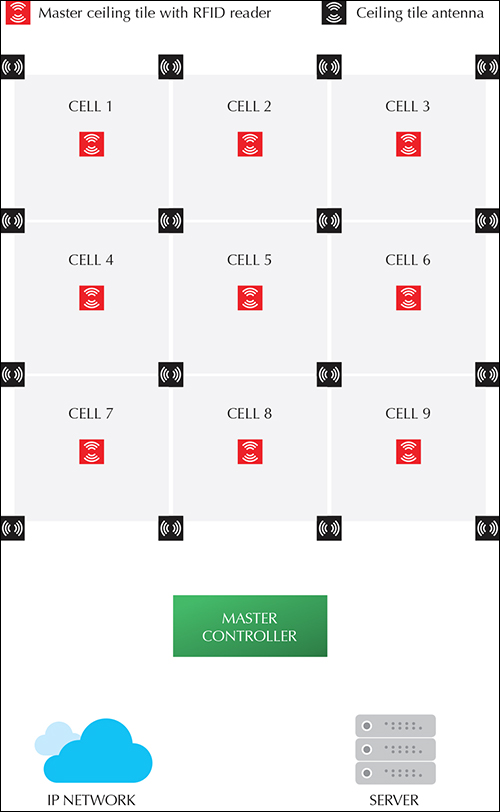U.K.-based technology company PervasID has released the latest version of its ultrahigh-frequency (UHF) RFID flat ceiling tile antenna reader system, known as the Space Ranger 9200, that, according to the company, offers an easier installation than its predecessor, with 75 percent fewer antennas and 50 percent less cabling requirements. The system is designed to accomplish near-100-percent tag-read accuracy within zones, in real time, the firm reports. The new product has been trialed by several companies in the retail and health-care sectors, and is being commercially launched now.
The wide-area passive RFID reading system is designed to capture RFID tag reads within approximately 4,500-square-foot cells, says Sithamparanathan Sabesan, the company’s CEO. It differs from other overhead fixed RFID systems, in that it requires fewer antennas to capture read data, and offers more than 99 percent read accuracy in real time.

Most overhead UHF RFID readers, Sabesan says, can read tags within a zone, but with less accuracy (typically 80 percent, according to PervasID) than the Space Ranger 9200, because traditional systems must contend with areas of low RF transmission in which tags can be missed. To ensure that all tags are read within a zone, tags in those low-transmission areas typically need to be moved from time to time. That means real-time tag capture isn’t being accomplished with every tag.
The Space Ranger was created to resolve that issue, the company reports. PervasID was launched in 2011, after its founders, from the University of Cambridge, — developed an RFID reader that employs a distributed antenna system (DAS) consisting of an array of antennas that capture data ID numbers within the reader’s zone (see UK Startup Company Launches ‘Wide-Area’ EPC RFID Prototype System). PervasID’s reader can transmit RF signals across wide beams that fill a zone and capture the presence of an RFID tag,
The Space Ranger 9100 was the first product release, which has been trialed by a handful of companies—primarily apparel retailers—that have asked to remain unnamed. The 9200 has since been developed, and is being trailed this year by some of the same companies.
The 9200 offers multiple benefits over the 9100, Sabesan says. While the 9100 was deployed with eight antennas, each cabled to that reader, the 9200 uses considerably fewer antennas. A single reader is centered in a “cell” or zone, with four antennas positioned at the cell’s four corners. The deployment would consist of a ceiling grid of cells, so that each antenna could serve as the corner antenna for three cells within its proximity. Since one antenna serves several cells, that means that there would be 75 percent fewer antennas installed overall than with the 9100. In addition, the center master reader, with its own built-in antenna, uses Power-over-Ethernet and links data back to a gateway (known as the master controller), with as many as 32 readers linked to a single gateway.
“We believe there are three main benefits” that the Space Ranger 9200 offers over other RFID reader systems, Sabesan says. He identifies those benefits as more than 99 percent detection accuracy over a wide area (accomplished by the company’s patented DAS technology) in real time, a relatively lower cost of installation and hands-free use, and flexibility provided by a simple installation.
Users could either purchase ceiling tiles with the Space Ranger RFID hardware built in, to replace some of their existing tiles, or install the hardware directly behind their existing tiles. The readers would then capture tag reads within the zones, and that data would be sent back to the gateway, which would communicate with a server.
PervasID provides an application programming interface (API) that integrates the read data with integration software. The RFID company is working with a number of systems integrators that offer software to manage and share the collected read data. Because the system requires less hardware and is relatively simple to install, Sabesan says, the typical return on investment (based on labor savings, as well as sales lifts from more accurate inventory management, in the case of retail) is typically less than 12 months.
The cells can be operated throughout the various merchandising seasons in a store as well. “Our experience is that retailers want a system independent of the items being tracked,” Sabesan says. Once the Space Ranger system is in place, the merchandise can be tracked throughout the zones, and those same zones can be allocated for different types of merchandise, according to seasons. The simple deployment model, he says—requiring only a few ceiling tile replacements and four antenna cables per reader—makes it relatively flexible for the variety of building infrastructures with which stores must work.
In the case of hospitals, the Space Ranger 9200 could be used to track the movements of assets within zones, such as patient rooms, operating suites or emergency departments to ensure that assets can be found when needed for patient care.
PervasID will demonstrate the new reader next week at the RFID Journal LIVE! 2017 conference and exhibition, being held in Phoenix, Ariz.


